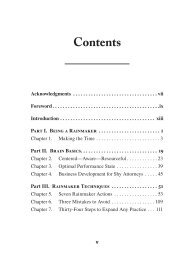(Bk Business) Carol Kinsey Goman Ph.D.-The Nonverbal Advantage_ Secrets and Science of Body Language at Work -Berrett-Koehler Publishers (2008)
Just
Just
Create successful ePaper yourself
Turn your PDF publications into a flip-book with our unique Google optimized e-Paper software.
Chapter 5: Talking with Your H<strong>and</strong>s<br />
97<br />
Gestures <strong>of</strong> anger Gripping the h<strong>and</strong>s behind the back<br />
<strong>of</strong>ten indic<strong>at</strong>es anger or frustr<strong>at</strong>ion.<br />
Finger pointing Finger<br />
pointing <strong>and</strong> finger wagging<br />
are parental gestures<br />
<strong>of</strong> scolding, <strong>and</strong> I’ve <strong>of</strong>ten<br />
seen politicians <strong>and</strong> executives<br />
use this gesture in<br />
meetings, negoti<strong>at</strong>ions, or<br />
interviews for emphasis or<br />
to show dominance. <strong>The</strong><br />
problem is th<strong>at</strong> r<strong>at</strong>her than<br />
being a sign <strong>of</strong> authority,<br />
aggressive finger pointing<br />
(with one or four fingers)<br />
suggests th<strong>at</strong> the person is<br />
A favorite gesture<br />
<strong>of</strong> the <strong>of</strong>fice bully<br />
losing control <strong>of</strong> the situ<strong>at</strong>ion,<br />
<strong>and</strong> it smacks <strong>of</strong> playground bullying.<br />
Gestures <strong>of</strong> interest Of course, not all gestures are neg<strong>at</strong>ive.<br />
Genuine interest is shown when the h<strong>and</strong> lightly rests<br />
on the cheek <strong>and</strong> is not used for head support.<br />
Chin stroking is a signal th<strong>at</strong> the listener is evalu<strong>at</strong>ing<br />
wh<strong>at</strong>’s been said. You need to look for the gesture th<strong>at</strong> immedi<strong>at</strong>ely<br />
follows the chin stroke. If<br />
the person leans forward, “steeples”<br />
his h<strong>and</strong>s, or gives any other<br />
positive signal, the decision has<br />
most likely gone in your favor. If,<br />
however, he leans back <strong>and</strong> crosses<br />
his arms, you may be in trouble.<br />
He’s evalu<strong>at</strong>ing wh<strong>at</strong> you<br />
said, but his raised eyebrow<br />
says he’s still skeptical.




